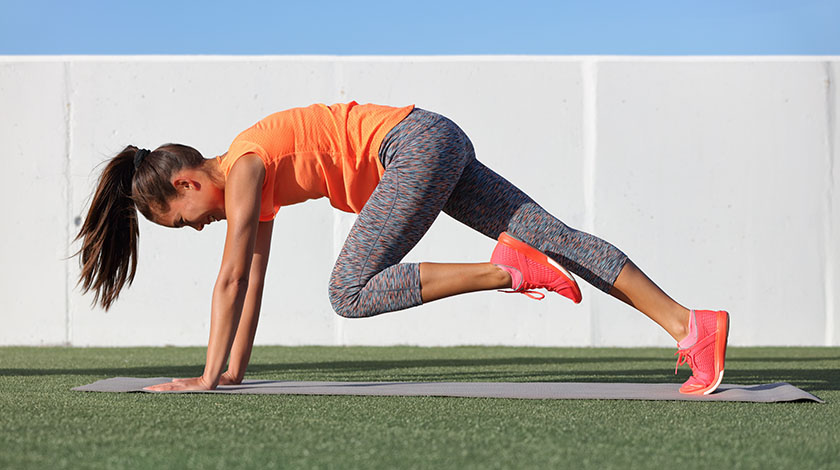High Intensity Interval Training (or HIIT) is increasingly popular among busy Hong Kongers, and it’s not hard to see why. With our hectic schedules, carving out time to work out can be difficult, and when we do get in the gym, having to rush through our workout is hardly productive.
That’s where HIIT comes in.
What is HIIT?

HIIT workouts cycle between short but intense intervals of extremely vigorous exercise such as sprinting, swimming or weight-lifting, followed by short rests. They kickstart your metabolism and provide a challenging aerobic workout, without taking up too much time.1
What are the benefits of HIIT?
Researchers have found that a thrice-weekly HIIT workout can improve aerobic and muscular performance and reduce risk of heart disease.1 It consists of four-minute exercise intervals followed by three-minute rest periods, repeated four times (a “4x4” workout).
If you do the math, that’s real bang for your buck — demonstrable results with just over an hour of exercise per week!
Extended Reading: The Best Time to Work Out
Try HIIT workout
Try out this HIIT workoutthat can be done at home. Do the entire circuit four times to complete the workout within 30 minutes: an interval of 30 seconds of work plus 30 seconds of rest including butt kicker, lunges, pop squat, skater jumps and forearm plank hold.
What is Tabata?
Being one type of HIIT workout, Tabata consists of eight sets of fast-paced exercises each performed for 20 seconds interspersed with a brief rest of 10 seconds.2 This four-minute-long training focuses on exerting maximum effort for a minimal amount of time. What’s more, you don’t necessarily need a fancy commercial gym or thousands of dollars of equipment. All that’s required is a kettlebell and some dumbbells.
What are the benefits of Tabata?
Evidence suggests that Tabata training is up to five times more effective at burning calories than traditional cardio in four minutes.3 Also, it helps protect muscle tissue, increase anaerobic and aerobic capacities.
If you need any further incentive, keep in mind that the Tabata Protocol was designed for Olympic athletes — so you know it works! There’s now no excuse not to get your weekly dose of exercise.
Extended Reading: Stop Making Excuses: How to Motivate Yourself to Workout?
Try Tabata workout
Here’s a sample Tabata workout, which takes you through both high-impact explosive exercises such as squat jumps and kettlebell swings, and low-impact exercises like burpees and side taps that improve joint mobility and static strength.
What are the differences between HIIT and Tabata?
Typical HIIT workouts have intervals of two to three minutes and a duration between 20 and 40 minutes of complete work, while Tabata is a type of HIIT that’s more specific in its interval timing and has shorter recovery periods. In general, Tabata has a higher intensity than a traditional HIIT workout.4
New fitness trend: AMRAP
Want to push yourself to the limit? Challenge yourself to a recently re-emerged fitness trend — AMRAP, which stands for “As Many Reps As Possible”. It is a form of high-intensity training that requires you to do as much as you can in a set amount of time — only it does not have fixed work and rest periods like HIIT and Tabata. 5
AMRAP can last any time frame you want it to be, depending on your fitness level. It’d be helpful to have a predetermined routine before you start. An example of an AMRAP workoutfor strength capacity is as many rounds of 10 air squats, 10 push-ups, 5 reverse lunges, and 10 prone Y lifts in 6 to 8 minutes with no rest period after each exercise.
AMRAP pushes the body to its limits and creates a metabolic overload, which helps with endurance and muscle-building in the long run. It also helps you to maximise your workout efficiency, helps with stripping fat and is suitable for all fitness levels.6 Both at home and the gym, it is worth giving it a try for an effective and efficient workout.
Sources
- https://www.scmp.com/lifestyle/health/article/1393222/why-high-intensity-interval-training-perfect-hectic-hongkongers
- https://www.merriam-webster.com/words-at-play/what-does-tabata-mean-hiit
- https://www.al.com/living/2013/06/new_study_by_aum_professor_sug.html
- https://www.healthline.com/health/exercise-fitness/tabata-vs-hiit#tabata-vs-hiit
- https://www.lifestyleasia.com/bk/living/wellness/fitness-trend-amrap/
- https://www.chontelduncan.com/blogs/fitness/amrap

